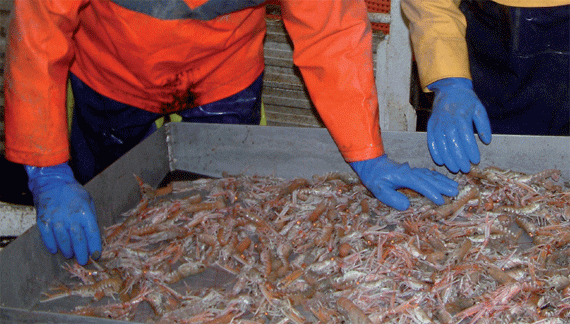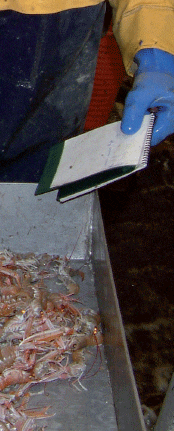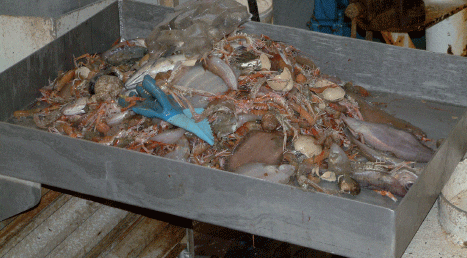
What is discarding?
Discards are those parts of a catch that are thrown back into the sea. Discards can be fish of any size and species, shellfish or benthic debris. To the catching sector, the traditional understanding of discards has been the small fish under the minimum landing size (MLS) that are brought onboard and then thrown back as they are not allowed to land them by law.
If we look back to the 1970s in the North Sea trawling and seine net fishery, before the advent of shelter decks, fish reception hoppers and conveyers, the skipper had a much better impression of what was being discarded as he could see his crew having to physically shovel up the catch, select fish to retain then dump the rest over the side. Nowadays it is very easy for the crew and skipper to have a false impression of the proportion of catch that they are discarding.
On modern vessels the part of the catch that is being discarded does not need to be handled at all, only the retained catch is picked off the conveyor. The discards are disposed of, relatively unnoticed, through a hatch in the side of the boat.
There are vastly different discard issues dependent on the type of fishery and the different types of gear used. Some fisheries have zero discards, whereas others are recorded as discarding as much as 70-80% of the total catch. There has been a lot of publicity recently on the discards issue, particularly with UK vessels which use all forms of towed gear.
Why are fish discarded?
Fish are discarded for various reasons but the practice is mostly driven by political/ regulatory factors or economic factors. Regulations dictate the amount of fish (Total Allowable Catch or quota), the proportion of species and the size of fish (minimum landing size) that can be landed. Fish may also be discarded for economic reasons - this could be because there is no commercial market, or they are of low value, or they are damaged.
There can be numerous categories of discards but four basic classifications are particularly relevant to UK fisheries.
A. Traditional discards of undersized fish and fish for which there is no market.
B. Fish above the MLS that are not worth landing due to low price.
C. Fish that cannot be landed due to quota restrictions or catch percentage rules.
D. Crustacea, benthic debris, etc.
A. Traditional discards of undersized fish and fish for which there is no market
There are several methods that been developed to limit the excessive catch of undersized species such as minimum mesh sizes, mesh orientation and twine thickness regulations. A discard reduction device has not yet been developed which will successfully create a clear cut off between retaining all fish above MLS in the net, and releasing all fish below MLS.
There has to be an overlap or grey area, the fishermen have to accept that there will be a loss of a certain percentage of fish above the MLS, and equally the legislators accept a small number of fish below the MLS will be caught with any selective device if the fishing industry is to remain viable.
There are also many species that fishermen regularly discard which have little, or a very limited value on the market. This can be due to the vessel not catching a high enough volume to justify keeping and landing, or the buyers ashore not being able to create a market for the low volumes of that particular species, or there being no demand from the consumers for the particular species.

B. Fish above the MLS that are not worth landing due to low price
Fish above the MLS that are not landed due to their low value is often referred to as high grading. This is not a modern problem it has happened in varying degrees for many years.
To start with, a skipper may have wanted to maximise his returns from his catch and only retained the larger fish that commanded the better prices on the market. It may have been the vessels regular practice to knowingly discard the selection of fish just above the MLS to ensure that they landed a higher value product and there was no chance of them inadvertently landing undersized fish.
Near the end of a trip, as fish room space was becoming a premium, some boats would discard more of the smaller fish, and sometimes whole species, only keeping the higher value selections of fish. With the introduction of stricter quotas there was more incentive to discard low value size selections to maximise value of the allowed quota.
C. Fish that cannot be landed due to quota restrictions or catch percentage rules
This is fish of all sizes that could command a good market price but the vessel does not have quota for and the fishermen are forced to go against their instinct and discard valuable fish.
Sometimes the skipper could lease quota to allow him to land this fish, but with the current cost of leasing being viable only for the best fish at the best market prices, many skippers have no option but to dump good fish. This is the category that is the most difficult to efficiently prevent capturing through gear alterations and modifications, because many of the gears have been developed over the past 60 – 70 years to catch this class and species of fish.
There is no real incentive for the industry to spend a lot of time, money and effort in redesigning the gear to avoid capture of these vulnerable species because stock assessments and/or quota allocation may change in the future.

D. Crustacea, benthic debris, etc
This is the category that fishermen would hardly class as discards as many of them have no market value. Also the amount of this type of discard caught in any gear depends very much on the gear type, and there will be a big variation in the quantity caught.
Many gears that are rigged to work just lightly on, or actually clear of the seabed, will have zero discards in this category. Other gears that are designed to catch fish and shellfish that live tight on the seabed will have large proportion of their catch as category D discards, unless the gear has already been modified to reduce the retention of this class of discards.
Because this type of benthic debris can damage the catch, resulting in poorer prices on the market, and there is the possibility of severe gear damage with it, many skippers have already modified their gear to reduce the quantity of benthic debris entering the trawl.
Find out exactly how much is being discarded
Before we can address the problem, we need to determine exactly how much fish, and of which species, are being discarded. It may be worthwhile for a skipper to make some elementary estimations of their catch profile.
All skippers can accurately judge the bulk of the catch as it comes aboard and is emptied into the hopper, usually this is measured in boxes. From this figure, subtract the number of boxes of fish and nephrops filled in the fishroom. Then ask ‘what is the rest?’ It’s discards!
There will be a percentage of the discards from the conveyor that will be nephrop heads and fish guts, but most skippers will be surprised how much actual fish they are discarding.
If a further check is required, collect a half basket of what is going over the side from the conveyor and pick out all the fish (including the ones that are only 50mm long), and sort them into different species. Now estimate how much of each species would have been in the whole catch, then the work it out for the entire trip, then calculate for a year. It will probably come out to a horrendous figure.
Don’t console yourself saying ‘it is just small fish’; they still count as one discard - whether the fish are 50mm long or 500mm long! If they had not been caught and discarded dead or dying they could have lived on and have spawned, at least once, and then be available to catch at a marketable size. Even if only 30% survived to this stage, imagine how much fish could be in the sea.
March 2012

